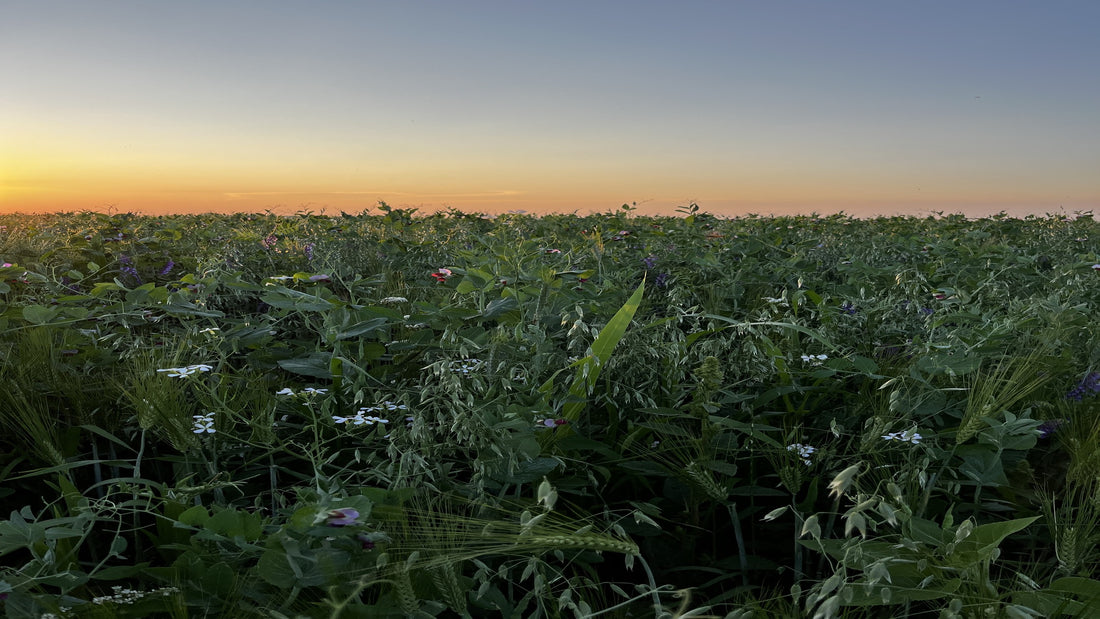The best part of an Alberta summer drive is viewing the many crop fields covering the countryside. From dark green alfalfa to yellow-blooming canola and golden wheat fields, cropland contributes significantly to Alberta’s beauty.
What you’re seeing from your car window is a conventional system of cropping called monoculture. Monocultures are single plant species grown in one field each season.
Monoculture has proven to be an efficient way for farmers to grow high yielding commodity crops using standardized practices to provide fertility and control weeds and pests.
However, when compared to natural landscapes, croplands lack an important feature, diversity of species. Consider a Prairie grassland that contains 20-30 plant species in just a few acres. This is very different than thousands of acres of a single crop. There is a growing interest in the consequences of monocultures on soil health, plant health, and even human health.
Let's delve into a new farming technique and some of the advantages we're witnessing firsthand on our own farm.
What is regenerative agriculture?
Regenerative agriculture is a rapidly growing movement among farmers and ranchers. This movement aims to work with nature by mimicking natural processes to grow plants and raise animals.
One part of regenerative agriculture is a “new” method of cropping called poly cropping where multiple species of plants are grown in the same field for the season. This method can also be referred to as cover cropping.
We've tried this method on our farm to feed our grass-fed cattle during winter and for fall grazing Here are seven reasons why we’re experimenting with poly cropping.
Poly crops require lower fertilizer inputs.
Poly crops incorporate species of plants called legumes, such as peas, clover, and vetch.
Legumes have the unique ability to form symbiotic relationships with soil bacteria. The bacteria form nodules on the roots of legumes.

Inside the nodules, bacteria can convert nitrogen in the atmosphere to a usable form of nitrogen for the plant. It is not fully known if the nitrogen being fixed is available to other plants or just the legumes themselves, but farmers growing poly crops have observed less need for nitrogen fertilizer or have omitted it completely. The following year the nitrogen will be available to in the soil and can be measured with soil tests.
Poly crops provide more beneficial bacteria and fungi in the soil.
Different plant species attract unique types of bacteria and fungi that help make nutrients available to plants naturally.
One example of this is mycorrhizal fungi. This type of fungi aids in conveying nutrients from the soil to the plant roots. The fungi branch out into areas of the soil where plants roots aren’t reaching, greatly expanding the area of nutrients available to the plant.
This barely scratches the surface of the complexity of soil, plant, and atmospheric interactions. Research is revealing more each year.
Poly crops reduce compaction.
Poly crops often include oats, which have fibrous roots that improve soil structure by breaking up compacted layers and promoting aeration.

Poly crops offer natural pest control.
In a mono crop, insect pests can often become a problem quickly. This happens when there are lots of plants for them to eat and not many predators around.
This often results in the pest populations getting out of control causing damage to the crop. Because poly crops have so many different species, they attract a host of beneficial insects that naturally predate on the problem insects. This helps to keep populations of insects balanced naturally protecting the crop.
Poly crops are good for pollinators.
Poly crops include flowering plants like buckwheat, clover, and sunflowers, attracting bees for pollination.

Bees play a crucial role in pollination, vital for plant reproduction and survival. They collect nectar and pollen from poly crop flowers, transferring pollen for fertilization and seed formation.
By attracting bees, poly crops contribute to a healthy environment and ecological sustainability.
Poly crops support a healthy nutritional profile.
The cattle's diet influences the fatty acid profile of their meat. Grasses are higher in omega-3 fatty acids compared to grains and concentrated feeds. Diets rich in grass and pasture promote a more favorable omega 6:3 ratio in the meat. In grass finished cattle we are looking for an omega 6:3 ratio of 2:1 compared to 20:1 in grain fed beef. Poly crops can help us achieve this goal because they have a low omega 6:3 ratio.
Poly crops provide natural crop insurance.
Growing multiple species in a poly-crop system increases resilience in the face of pests, weather fluctuations, and varying moisture levels. The array of species in a poly crop provides resilience and adaptability to different environmental conditions.
Some species thrive in cooler soils, taking advantage of lower temperatures and adapting to such conditions. These plants are well-suited to withstand and flourish in cooler environments.
Other species prefer warmer soil and can tolerate drier conditions. These plants thrive in environments with higher temperatures and lower moisture availability.
Planting a mix of both species adds resilience to the system ensuring that there will be a harvestable crop at the end of the year. Unless it hails!

This year we are growing a poly crop with 15 different plant species. We will harvest it in August as silage for winter feed. Some of the species will keep growing through August and September to provide high-quality fall grazing.
Cool season species:
- Italian rye grass
- Hairy vetch
- Forage oats
- Forage barley
- Forage peas
- Spring triticale
- Daikon radish
- Purple top turnip
- Berseem clover
- Flax
Warm season species:
- Sorghum Sudan grass
- German millet
- Non-GMO soybeans
- Sunflower
- Buckwheat
Visit our online shop today to experience the exceptional quality and flavour of our grass fed, grass finished beef.
Let's Connect!
Follow us on Facebook, Twitter and Instagram
Subscribe to our newsletter to stay up-to-date with all of our pro tips, recipes, and upcoming events!

